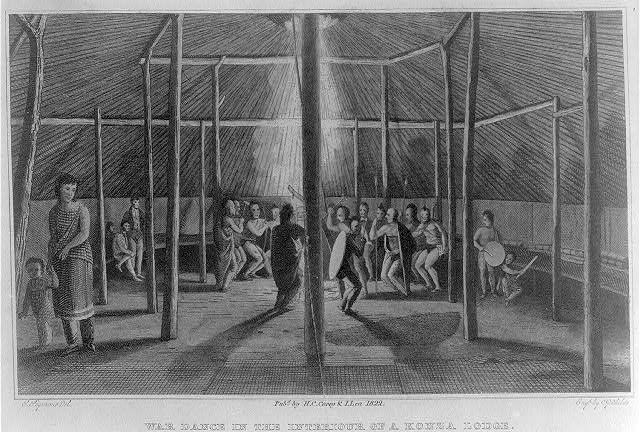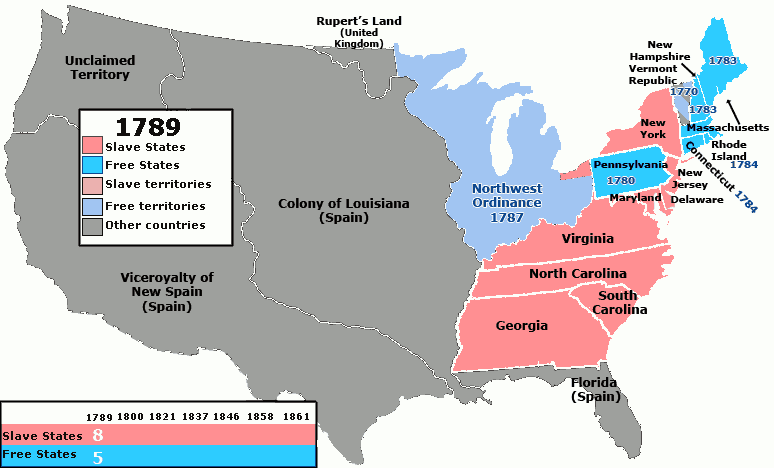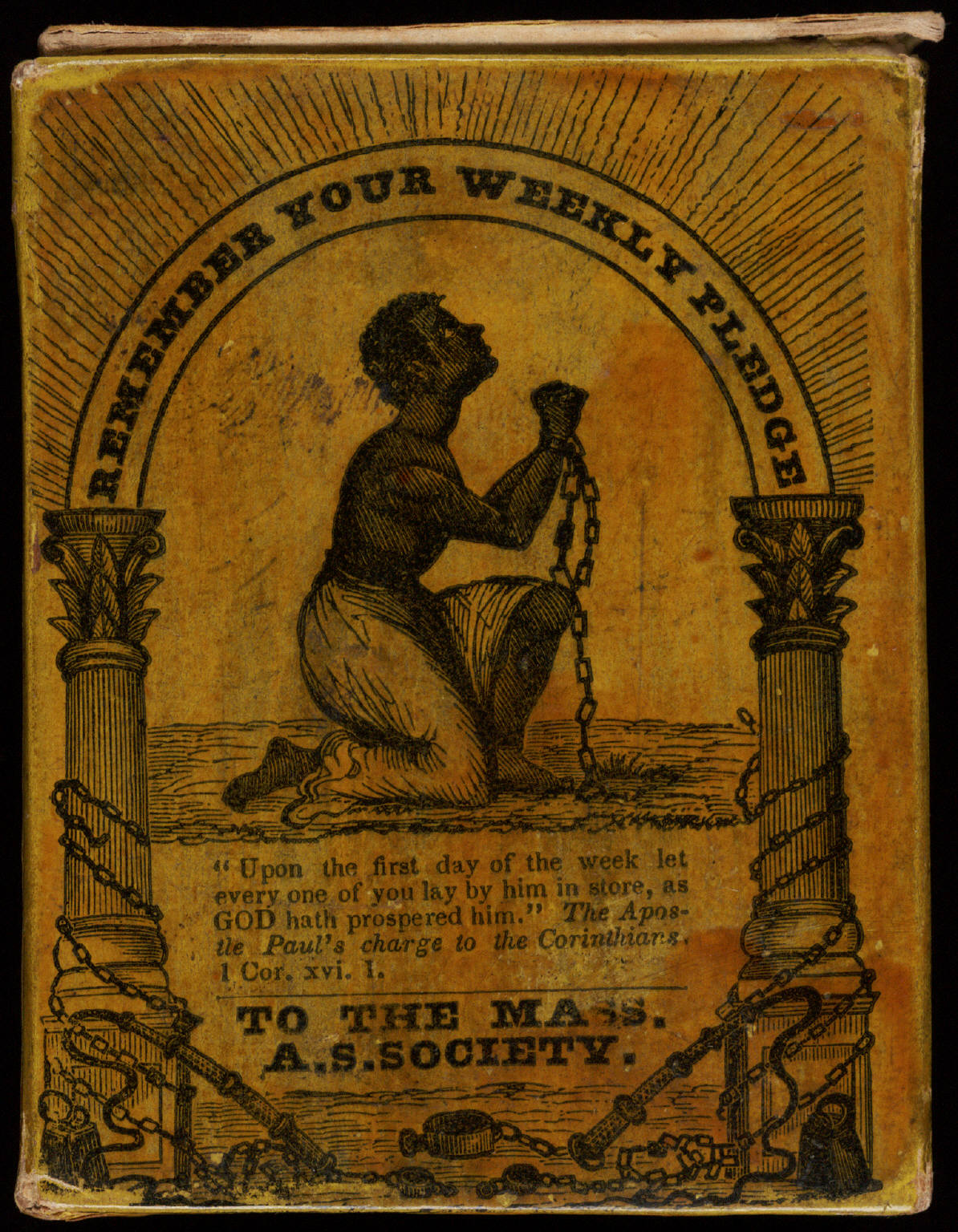|
History Of Slavery In Kansas
Slavery in Kansas remained small-scale and mainly at the household level. Since cotton never had a significant role in Kansas' early agrarian economy, there were a few plantations and slaves along the Missouri River during the pre-Territorial period. Starting with the organization of Kansas Territory in 1854, there was a state-level civil war over slavery which inhibited the development of the institution of slavery. History The number of slaves in Kansas Territory was estimated at 200. Men were engaged as farm hands, and women and children were employed in domestic work. The U.S. Census in spring 1860 counted only 2 slaves in Kansas; both were women who lived in Anderson County, Kansas. The presence of slaveowners in Kansas, particularly slaveowners who had migrated from the neighboring slave state of Missouri in order to guarantee the future state's entry into the Union as a slave state, served as a motivating factor for Northern abolitionist movements to move into the Kansas ... [...More Info...] [...Related Items...] OR: [Wikipedia] [Google] [Baidu] |
Kansas
Kansas ( ) is a landlocked U.S. state, state in the Midwestern United States, Midwestern region of the United States. It borders Nebraska to the north; Missouri to the east; Oklahoma to the south; and Colorado to the west. Kansas is named after the Kansas River, in turn named after the Kaw people, Kansa people. Its List of capitals in the United States, capital is Topeka, Kansas, Topeka, and its List of cities in Kansas, most populous city is Wichita, Kansas, Wichita; however, the largest urban area is the bi-state Kansas City metropolitan area split between Kansas and Missouri. For thousands of years, what is now Kansas was home to numerous and diverse Plains Indians, Indigenous tribes. The first settlement of non-indigenous people in Kansas occurred in 1827 at Fort Leavenworth. The pace of settlement accelerated in the 1850s, in the midst of political wars over the Slavery in the United States, slavery debate. When it was officially opened to settlement by the U.S. governm ... [...More Info...] [...Related Items...] OR: [Wikipedia] [Google] [Baidu] |
Missouri River
The Missouri River is a river in the Central United States, Central and Mountain states, Mountain West regions of the United States. The nation's longest, it rises in the eastern Centennial Mountains of the Bitterroot Range of the Rocky Mountains of southwestern Montana, then flows east and south for before entering the Mississippi River north of St. Louis, Missouri. The river drains Semi-arid climate, semi-arid Drainage basin, watershed of more than 500,000 square miles (1,300,000 km2), which includes parts of ten U.S. states and two Canadian provinces. Although a tributary of the Mississippi, the Missouri River is slightly longer and carries a comparable volume of water, though a fellow tributary (Ohio River) carries more water. When combined with the lower Mississippi River, it forms the List of rivers by length, world's fourth-longest river system. For over 12,000 years, people have depended on the Missouri River and its Tributary, tributaries as a source of sustena ... [...More Info...] [...Related Items...] OR: [Wikipedia] [Google] [Baidu] |
Kansas Territory
The Territory of Kansas was an organized incorporated territory of the United States that existed from May 30, 1854, until January 29, 1861, when the eastern portion of the territory was admitted to the United States, Union as the Slave and free states, free state of Kansas. The territory extended from the Missouri border west to the summit of the Rocky Mountains and from the 37th parallel north to the 40th parallel north. Originally part of Missouri Territory, it was unorganized from 1821 to 1854. Much of the eastern region of what is now the Colorado, State of Colorado was part of Kansas Territory. The Territory of Colorado was created to govern this western region of the former Kansas Territory on February 28, 1861. The question of whether Kansas was to be a free or a slave state was, according to the Compromise of 1850 and the Kansas–Nebraska Act, to be decided by popular sovereignty, that is, by vote of the Kansans. The question of which Kansans were eligible to vote ... [...More Info...] [...Related Items...] OR: [Wikipedia] [Google] [Baidu] |
Anderson County, Kansas
Anderson County is a County (United States), county located in East-Central Kansas, East Central Kansas, in the Central United States. Its county seat and most populous city is Garnett, Kansas, Garnett. As of the 2020 United States census, 2020 census, the county population was 7,836. The county was named for Joseph C. Anderson, a Kansas territorial legislator and border ruffian during the "Bleeding Kansas" era. History In 1854, the Kansas Territory was organized, and in 1855, Anderson County was established as one of the original 33 counties of the Kansas Territory, named for territorial legislator Joseph C. Anderson. The initial settlement began in 1854 with individuals such as Valentine Gerth and Francis Meyer staking claims near what would become Greeley, Kansas, Greeley. The settlers discovered fields previously worked by the Potawatomi, who had been relocated there in 1833. The early years were fraught with conflict during "Bleeding Kansas," with Anderson County men eng ... [...More Info...] [...Related Items...] OR: [Wikipedia] [Google] [Baidu] |
Slave States And Free States
In the United States before 1865, a slave state was a state in which slavery and the internal or domestic slave trade were legal, while a free state was one in which they were prohibited. Between 1812 and 1850, it was considered by the slave states to be politically imperative that the number of free states not exceed the number of slave states, so new states were admitted in slave–free pairs. There were, nonetheless, some slaves in most free states up to the 1840 census, and the Fugitive Slave Clause of the U.S. Constitution, as implemented by the Fugitive Slave Act of 1793 and the Fugitive Slave Act of 1850, provided that a slave did not become free by entering a free state and must be returned to his or her owner. Enforcement of these laws became one of the controversies that arose between slave and free states. By the 18th century, slavery was legal throughout the Thirteen Colonies, but at the time of the American Revolution, rebel colonies started to abolish the pra ... [...More Info...] [...Related Items...] OR: [Wikipedia] [Google] [Baidu] |
Missouri
Missouri (''see #Etymology and pronunciation, pronunciation'') is a U.S. state, state in the Midwestern United States, Midwestern region of the United States. Ranking List of U.S. states and territories by area, 21st in land area, it borders Iowa to the north, Illinois, Kentucky and Tennessee to the east, Arkansas to the south and Oklahoma, Kansas, and Nebraska to the west. In the south are the Ozarks, a forested highland, providing timber, minerals, and recreation. At 1.5 billion years old, the St. Francois Mountains are among the oldest in the world. The Missouri River, after which the state is named, flows through the center and into the Mississippi River, which makes up the eastern border. With over six million residents, it is the List of U.S. states and territories by population, 19th-most populous state of the country. The largest urban areas are St. Louis, Kansas City, Missouri, Kansas City, Springfield, Missouri, Springfield, and Columbia, Missouri, Columbia. The Cap ... [...More Info...] [...Related Items...] OR: [Wikipedia] [Google] [Baidu] |
Abolitionism In The United States
In the United States, abolitionism, the movement that sought to end slavery in the United States, slavery in the country, was active from the Colonial history of the United States, colonial era until the American Civil War, the end of which brought about the abolition of American slavery, Penal labor in the United States, except as punishment for a crime, through the Thirteenth Amendment to the United States Constitution (ratified 1865). The anti-slavery movement originated during the Age of Enlightenment, focused on ending the Atlantic slave trade, transatlantic slave trade. In Colonial America, a few German Quakers issued the 1688 Germantown Quaker Petition Against Slavery, which marked the beginning of the American abolitionist movement. Before the American Revolutionary War, Revolutionary War, Evangelicalism in the United States, evangelical colonists were the primary advocates for the opposition to Slavery in the colonial United States, slavery and the slave trade, doing ... [...More Info...] [...Related Items...] OR: [Wikipedia] [Google] [Baidu] |
Bleeding Kansas
Bleeding Kansas, Bloody Kansas, or the Border War, was a series of violent civil confrontations in Kansas Territory, and to a lesser extent in western Missouri, between 1854 and 1859. It emerged from a political and ideological debate over the legality of slavery in the United States, slavery in the proposed state of Kansas. The conflict was characterized by years of electoral fraud, raids, assaults, and murders carried out in the Kansas Territory and neighboring Missouri by proslavery "border ruffians" and retaliatory raids carried out by Abolitionism in the United States, antislavery "Free-Stater (Kansas), free-staters". According to ''Kansapedia'' of the Kansas Historical Society, 56 political killings were documented during the period, and the total may be as high as 200. It has been called a Tragic Prelude, or an overture, to the American Civil War, which immediately followed it. The conflict centered on the question of whether Kansas, upon gaining statehood, would join th ... [...More Info...] [...Related Items...] OR: [Wikipedia] [Google] [Baidu] |
American Civil War
The American Civil War (April 12, 1861May 26, 1865; also known by Names of the American Civil War, other names) was a civil war in the United States between the Union (American Civil War), Union ("the North") and the Confederate States of America, Confederacy ("the South"), which was formed in 1861 by U.S. state, states that had Secession in the United States, seceded from the Union. The Origins of the American Civil War, central conflict leading to war was a dispute over whether Slavery in the United States, slavery should be permitted to expand into the western territories, leading to more slave states, or be prohibited from doing so, which many believed would place slavery on a course of ultimate extinction. Timeline of events leading to the American Civil War, Decades of controversy over slavery came to a head when Abraham Lincoln, who opposed slavery's expansion, won the 1860 presidential election. Seven Southern slave states responded to Lincoln's victory by seceding f ... [...More Info...] [...Related Items...] OR: [Wikipedia] [Google] [Baidu] |
1st Kansas Colored Infantry Regiment
The 1st Kansas Colored Infantry Regiment was an infantry regiment that served in the Union Army during the American Civil War. It was the first black regiment organized in a northern state to see combat during the Civil War. At the Battle of Poison Spring, wounded and surrendering soldiers from the regiment were massacred. As a result, the regiment lost nearly half its number and suffered the highest losses of any Kansas regiment during the war. Service overview The 1st Kansas Colored Infantry was organized by Senator James Henry Lane at Fort Scott, Kansas and mustered in as a battalion of six companies on January 13, 1863 for three years. Four additional companies were recruited and mustered in between January 13 and May 2, 1863. It mustered in under the command of Colonel James Monroe Williams. The regiment was recruited without federal authorization and against the wishes of Secretary of War Edwin M. Stanton. James H. Lane, recruiting commissioner for Kansan territory ... [...More Info...] [...Related Items...] OR: [Wikipedia] [Google] [Baidu] |
Bates County, Missouri
Bates County is a County (United States), county located in the west central part of the U.S. state of Missouri, two counties south of the Missouri River and is part of the Kansas City metropolitan area. As of the 2020 United States census, 2020 census, the population was 16,042. Its county seat is Butler, Missouri, Butler. The county was organized in 1841 and named after Frederick Bates (politician), Frederick Bates, the second List of Governors of Missouri, Governor of Missouri. This mostly rural county has an overwhelmingly ethnic European-American population, which has declined in number since the early 20th century as people have moved to cities. History The borderlands of Kansas and Missouri were battlegrounds for insurgents during the American Civil War, with raids going back and forth across the border. Bates County is noted as the site for the first combat engagement during the war of African-American soldiers serving with the Union and against Confederate forces, whi ... [...More Info...] [...Related Items...] OR: [Wikipedia] [Google] [Baidu] |
History Of Racism In Kansas
History is the systematic study of the past, focusing primarily on the human past. As an academic discipline, it analyses and interprets evidence to construct narratives about what happened and explain why it happened. Some theorists categorize history as a social science, while others see it as part of the humanities or consider it a hybrid discipline. Similar debates surround the purpose of history—for example, whether its main aim is theoretical, to uncover the truth, or practical, to learn lessons from the past. In a more general sense, the term ''history'' refers not to an academic field but to the past itself, times in the past, or to individual texts about the past. Historical research relies on primary and secondary sources to reconstruct past events and validate interpretations. Source criticism is used to evaluate these sources, assessing their authenticity, content, and reliability. Historians strive to integrate the perspectives of several sources to develop a ... [...More Info...] [...Related Items...] OR: [Wikipedia] [Google] [Baidu] |








